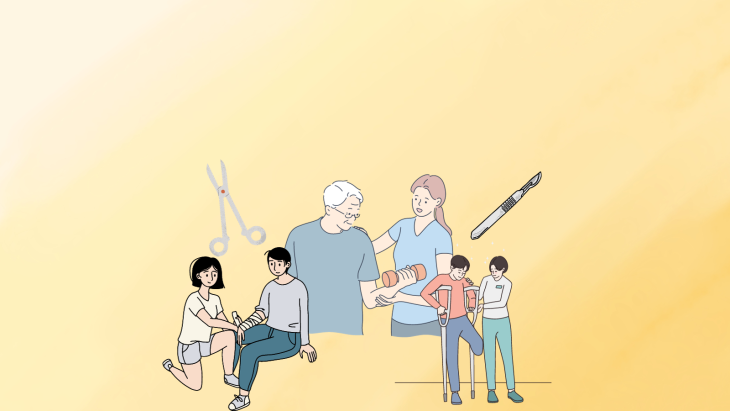Categories
Recent Posts
Popular
Recent Posts
- I broke up with my partner, but now I am having doubts. Did I do it out of the right reasons or was I just being fearful?
- My Quick Temper Pushes People Away. What Do I Do To Manage My Anger?
- How does noise affect my mental health?
- I want to be a better problem solver. What is a step by step approach?
- Escapism. When is it healthy? When is it damaging?
Most Popular
How Physical Therapy Can Help You Avoid Surgery?

How Physical Therapy Can Help You Avoid Surgery?
The possibility of surgical intervention in healthcare often crosses paths with the desire for wellbeing. Physical therapy, on the other hand, may provide an alternative route to recovery that circumvents the need for surgical intervention, according to an expanding body of evidence. Let's explore how physical therapy may help people who want to stay healthy without surgery.
Pain Management and Rehabilitation
Physical therapy is recognized for its remarkable effectiveness in pain management and
rehabilitation. Physical therapists treat musculoskeletal conditions that may otherwise require
surgery by using manual procedures, stretching techniques, and specific exercises. Patients can
gain through physical therapy, which improves joint function, flexibility, and strength without
requiring invasive procedures.
Preventing Degeneration
Many surgeries treat diseases that get worse over time, like osteoarthritis. On the other hand,
physical therapy concentrates on proactive steps to stop more degeneration. Therapists help
patients improve the supporting structures around their joints by making personalized exercise
plans. It can slow the development of degenerative diseases and maybe even prevent the need
for surgery.
Alignment and Postural Correction
Poor posture can be a contributing factor to a variety of health issues, such as chronic discomfort
and joint dysfunction. Physical therapists are experts in identifying and resolving postural
abnormalities, which reduces the need for surgical procedures to address chronic
musculoskeletal problems. Placing significant importance on body mechanics enables individuals
to sustain optimal alignment, thereby reducing the strain on joints and tissues.
Non-Invasive Remedies for Soft Tissue Injuries
Soft tissue injuries, such as rips in tendons or ligaments, frequently lead to discussions about
surgery. Yet, non-invasive remedies that support recovery are provided by physical therapy.
Individuals can restore functioning without surgery using specific exercises, manual treatment,
and technologies like ultrasound or electrical stimulation to speed up healing.
Holistic Approach to Wellness
Physical therapy is a holistic approach to well-being beyond treating particular problems.
Therapists consider ergonomics, lifestyle factors, and overall physical health to develop
comprehensive treatment plans. Embracing a holistic approach facilitates injury prevention
and enhances general well-being by decreasing the necessity for surgical interventions.
In summary, physical therapy is an effective ally on the journey to optimal health, providing an
alternative method for recovery than surgery. Physical therapy enables people to regain their
health without requiring invasive surgeries through pain management, preventative techniques,
posture correction, soft tissue rehabilitation, and a holistic approach to well-being. As we learn
more about physical therapy, it becomes clear that this non-invasive form of therapy is not only a
treatment option but also a light of hope for people who want to stay healthy and avoid surgery.
The possibility of surgical intervention in healthcare often crosses paths with the desire for wellbeing. Physical therapy, on the other hand, may provide an alternative route to recovery that circumvents the need for surgical intervention, according to an expanding body of evidence. Let's explore how physical therapy may help people who want to stay healthy without surgery.
Pain Management and Rehabilitation
Physical therapy is recognized for its remarkable effectiveness in pain management and
rehabilitation. Physical therapists treat musculoskeletal conditions that may otherwise require
surgery by using manual procedures, stretching techniques, and specific exercises. Patients can
gain through physical therapy, which improves joint function, flexibility, and strength without
requiring invasive procedures.
Preventing Degeneration
Many surgeries treat diseases that get worse over time, like osteoarthritis. On the other hand,
physical therapy concentrates on proactive steps to stop more degeneration. Therapists help
patients improve the supporting structures around their joints by making personalized exercise
plans. It can slow the development of degenerative diseases and maybe even prevent the need
for surgery.
Alignment and Postural Correction
Poor posture can be a contributing factor to a variety of health issues, such as chronic discomfort
and joint dysfunction. Physical therapists are experts in identifying and resolving postural
abnormalities, which reduces the need for surgical procedures to address chronic
musculoskeletal problems. Placing significant importance on body mechanics enables individuals
to sustain optimal alignment, thereby reducing the strain on joints and tissues.
Non-Invasive Remedies for Soft Tissue Injuries
Soft tissue injuries, such as rips in tendons or ligaments, frequently lead to discussions about
surgery. Yet, non-invasive remedies that support recovery are provided by physical therapy.
Individuals can restore functioning without surgery using specific exercises, manual treatment,
and technologies like ultrasound or electrical stimulation to speed up healing.
Holistic Approach to Wellness
Physical therapy is a holistic approach to well-being beyond treating particular problems.
Therapists consider ergonomics, lifestyle factors, and overall physical health to develop
comprehensive treatment plans. Embracing a holistic approach facilitates injury prevention
and enhances general well-being by decreasing the necessity for surgical interventions.
In summary, physical therapy is an effective ally on the journey to optimal health, providing an
alternative method for recovery than surgery. Physical therapy enables people to regain their
health without requiring invasive surgeries through pain management, preventative techniques,
posture correction, soft tissue rehabilitation, and a holistic approach to well-being. As we learn
more about physical therapy, it becomes clear that this non-invasive form of therapy is not only a
treatment option but also a light of hope for people who want to stay healthy and avoid surgery.







Comments